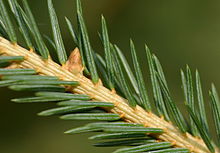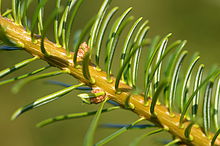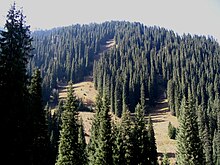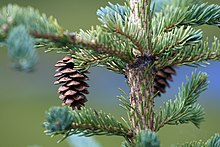Spruce trees
| Spruce trees | ||||||||||||
|---|---|---|---|---|---|---|---|---|---|---|---|---|

Norway spruce ( Picea abies ) |
||||||||||||
| Systematics | ||||||||||||
|
||||||||||||
| Scientific name of the subfamily | ||||||||||||
| Piceoideae | ||||||||||||
| Frankis | ||||||||||||
| Scientific name of the genus | ||||||||||||
| Picea | ||||||||||||
| A.Dietr. |
The spruce ( Picea ) form the only genus of the subfamily Piceoideae within the plant family of pine plants (Pinaceae). The only species native to Central Europe is the Norway spruce ( Picea abies ), which is also incorrectly referred to as the “red fir” because of its scaly, red-brown bark.
Description and ecology
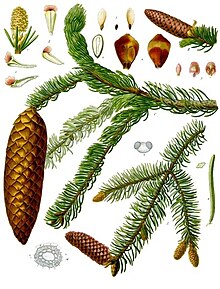
Appearance
Picea species are evergreen and single-stemmed trees . As a rule, they reach heights of growth of 20 to 60 meters, in exceptional cases over 80 meters, such as Picea sitchensis . The treetop is conical to cylindrical. The trunk diameter is up to 1 meter, up to a maximum of 2.5 meters; extreme values of up to 4 meters occur in individual species. A shrub-like growth occurs only under special site conditions or in mutants .
All Picea species are characterized by monopodial , acrotonic (on the upper or outer buds) promoted branching . This leads to a tiered crown structure and a pointed crown. The first-order side rungs are arranged in a pseudo-whirling arrangement and thus form individual "floors".
With increasing age, more proventive shoot formation occurs: dormant buds sprout on older branches. In older trees, these can build up a substantial part of the branches and coniferous mass of the crown.
Crown shape and shoot system vary depending on the environmental conditions and are partly genetic.
There are several different types of branching:
- With the panel spruce, the side rungs of a higher order are also arranged horizontally, so that the floors form individual “panels” (especially with Picea pungens , Picea torano ).
- In comb spruce, the side rungs hang down like a curtain from the second order (e.g. especially in Picea breweriana , Picea smithiana ).
- Brush spruce trees are an intermediate form in which the side branches protrude on all sides.
Young spruces usually have platy branches. The comb shape usually only appears from the age of 30.
Narrow crown, as it occurs in the so-called "pointed spruce", can, as in Picea omorika, be species-specific, i.e. genetically fixed. However, it can also occur in specific ecotypes or mutants ("spindle spruce"). Mostly, however, it is a site modification ("roller spruce") under high-montane subalpine or boreal subarctic climatic conditions. This modification also occurs in the common spruce ( Picea abies ) native to Central Europe .
Seedlings usually have four to nine (up to 15) cotyledons ( cotyledons ).
Twigs and buds
Young twigs have fine furrows. These are located between raised backs, which are formed by the sequence of "leaf cushions" (Pulvini). These leaf cushions are interpreted either as axis protuberances or as the leaf base . They end up in a stem-like extension. This extension ("needle stalk") is bark-colored and protrudes from the branch, which makes it look rasp-like. The actual needle sits on the needle stem. These two characteristics - furrows and protruding needle stalks - are specific to the genus Picea .
Buds are often oval to conical. Depending on the type, they are more or less gummy. The bud features are characteristic of each species. Flower buds and the preventive buds occurring in the basal parts, however, often deviate from these species-characteristic features.
Needles
Picea species have the evergreen, needle-shaped leaves typical of conifers , which are usually quite xeromorphic . The needles are separated from the bark-colored “needle stem” (leaf cushion) by a separating layer. Here the needle loosens after it dies: the needle shrinks at the contact surface due to water loss, but the lignified leaf cushion does not. The needles usually stay on the branches for six to 13 years, but they tend to fall off when stressed.
The morphology and anatomy of the needles are essential characteristics for the differentiation of the individual spruce species: needle cross-section, mesophyll structure , arrangement of the stomata and the resin canals .
The needles of each type are usually one of the following two types:
- equifacial / amphistomatic : the needles are ± square in cross-section, about as high as they are wide or even higher. The stomata are distributed on all sides, the needles are colored the same on all sides.
- inverse-dorsiventral / epistomatic : the needles are flattened dorsiventrally, wider than high. The stomatal lines are missing on the underside of the leaf and are only visible as white stripes on the upper side. The needles are therefore two-colored.
In the side branches of the Picea species, however, the tops of the needles point downwards, so that the white stripes appear to be on the underside of the needles.
The needles are usually 1 to 2 centimeters long and pointed or pointed, in some species even sharp and piercing (e.g. Picea pungens ).
The needles are arranged in a spiral on the branches. Nevertheless, there are species-specific differences in how the needles are arranged on the horizontally growing ( plagiotropic ) side branches: They can protrude from the branch all around, as in Picea asperata and Picea pungens , or on the underside of the branch strictly ( Picea glehnii ) or weak ( Picea schrenkiana ) be parted.
Flowers, cones and seeds
Picea species are monoecious separately sexed ( monoecious ), d. That is, there are female and male flower organs separated from each other on a tree. Bisexual flowers or inflorescences are only found in exceptional cases . The inflorescences are formed on the side shoots of the previous year. Flowering maturity occurs between the ages of 10 and 40 years. The flowering time takes place in the period April to June.
The male flowers are solitary, oblong-egg-shaped and 1 to 2 centimeters long. Initially they are purple to pink, then yellow when ripe. The pollen has two air sacs. The pollination is carried by the wind ( anemophily ).
The female cones usually arise from terminal buds. At first they are erect, but after fertilization they curve downwards. Immature cones are green, red to dark blue and black-violet in color. In some species there is even a color dimorphism , which is explained by a selection advantage of red / purple colored cones in alpine / boreal areas. The cones ripen between August and December and are then mostly brown, ovoid to cylindrical. The seeds fall out between August and winter, sometimes not until the next spring, so they are spread by the wind. Then the cones are thrown off as a whole. The cones are 2 to 20 centimeters long. The cover scales are always shorter than the seed scales and therefore not visible on the cone.
The seeds are relatively small with a length of 3 to 6 millimeters. Fertile seeds are dark brown to black, sterile seeds are lighter colored. Their wings are light, yellow or pinkish brown and about 6 to 15 millimeters long.
Distribution and site conditions

The genus Picea is distributed holarctic . Only in Mexico and Taiwan does it range up to the northern tropic . Different species of Picea are stock-forming in the boreal coniferous forest zone and in the coniferous forest level of many mountains in the climatically temperate, submeridional and meridional parts of Eurasia and North America . There are about seven species in North America; one species there is a neophyte .
Many of the Asian species are found in the mountains of the submeridional and meridional zones. There are a number of endemics here with narrowly defined areas.
In China and Central Asia, several species are found in the continental mountains of eastern Tibet and Turkestan . They form a plant-geographical link to the Siberian spruce ( Picea obovata ), whose area extends from eastern Siberia and Mongolia to the west of the Urals . To the west of this is the common spruce native to Europe .
The parallel species to Picea obovata in North America are Picea glauca and Picea mariana , which also form a broad forest belt in the boreal zone.
The Rocky Mountains are home to some continental species, such as Picea engelmannii and Picea chihuahuana , which extend as far as Mexico . There are only two oceanic species in North America ( Picea breweriana and Picea rubens ).
Picea species are generally undemanding in terms of nutrient supply. The oceanic species, however, need moist and well-aerated soils . Waterlogging of Picea TYPES not tolerated.
In 2008, root wood was found under a spruce in the province of Dalarna in Sweden , which was dated to an age of 9,550 years and is said to be genetically identical to the tree growing above it.
use
Spruce is one of the most important forest species in the northern hemisphere. Natural forests are only used in remnants, mostly cultivated or artificially created pure stands. In Central Europe, the common spruce is the bread tree of forestry. As with the other species, the decisive factors are the straight growth, the rapid growth, the low demands on the location and the good usability of the wood. However, the spruce prefers cool locations, such as B. the mountain regions. As a result, the stocks in the Central Plateau will decline with the presumably increasing global warming and will have to be replaced by other tree species in the future.
The range of applications includes, above all, its use in paper and pulp production , as construction and furniture wood for indoor use and as firewood . As sawn timber, spruce wood is usually traded and used together with fir wood as a mixed range of spruce / fir. Spruce wood is processed in the form of round wood , sawn timber such as boards and glued laminated timber and as veneer wood . At the same time, it is the most important wood for the production of wood-based materials such as plywood , glued wood , chipboard and fiberboard . As a special application, evenly grown trunks from the high mountains are used as tonewood especially for the soundboard of keyboard instruments or as a soundboard for plucked and stringed instruments .
The spruce forests have some important protective function in many high mountains and steep slopes, as they protect the populated valleys from avalanches and rockfalls as protective forests . Some species are also planted as ornamental trees in parks and gardens or used as Christmas trees.
Origin of name
The word picea was used by the Romans in the sense of "resinous wood: spruce" (Virgil, Aeneis 6,180), but also when referring to the common pine ( Pliny the Elder , Historia naturalis 16,40ff.). It is a noun of the adjective piceus = "pitch, resinous", which belongs to pix , genitive picis , "pitch, resin". This is attributed to the Indo-European root * pik- "Pech, Harz". The root * pit- "spruce" is close to this root .
Both roots are mostly associated with the Indo-European words for "fat, juice, drink". However, a connection with * (s) spade-, * (s) pit- "pointed, piercing" is also conceivable.
Evolution and systematics
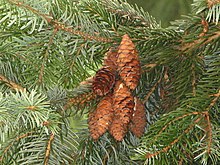

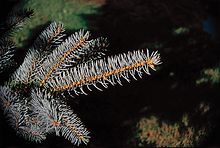
Both fossil and molecular biological data indicate that the genus Picea originated in North America. The oldest fossils (pollen) come from the Palaeocene Montanas (USA). Many cone fossils are known from the Eocene , but only from North America. The earliest fossils in Asia date from the Oligocene and Europe from the Pliocene . Via the Bering route, the genus might have reached Asia in one or two waves and from there on to Europe. The origin of the genus is likely to be in the late Cretaceous or early Tertiary.
The genus Picea alone forms the subfamily Piceoideae. The monophyly of the genus has never been questioned. The closest relatives within the family are the genera Cathaya and Pinus .
The system within the genus is classically established primarily on the basis of cone features, secondarily on needle features. A widely recognized system comes from Schmidt 1989, which is based on the system in the version by Schmidt 2004. Farjon 1990 also follows this classification, although he puts the taxa below the genus one level lower. Work (Ran et al. 2006) on a molecular biological basis justifiably cast doubt on this systematics developed on a morphological basis. However, there are still no new proposals for a phylogenetic system.
According to Schmidt's 2004 system, there are 35 species. Other authors give 28 to 56 species:
-
Subgenus Picea (Morinda cones):
-
Section Omorika :
- Sargent spruce ( Picea brachytyla (Franch.) E. Pritz. )
- Siskiyou spruce ( Picea breweriana S.Watson ): It thrives in montane to subalpine forests at altitudes of 1000 to 2300 meters only in the Siskiyou Mountains in the western US states of California and Oregon .
- Picea farreri C.N. Page & Rushforth
- Serbian spruce ( Picea omorika (Pančić) Purk. )
- Sikkim spruce ( Picea spinulosa (Griff.) A.Henry )
-
Section Omorika :
- Section Picea :
-
Subsection Marianae A.E. Murray :
-
Orientales T.S.Liu series :
- Caucasian spruce ( Picea orientalis (L.) Link )
- Rubentes A.E. Murray series :
- Sakhalin spruce ( Picea glehnii (F.Schmidt) Mast. )
- Black spruce ( Picea mariana (Mill.) Britton )
- American red spruce ( Picea rubens coffin. )
-
Orientales T.S.Liu series :
- Picea subsection
- Politae A.E. Murray series :
- Alcocks spruce ( Picea alcoquiana (Veitch ex Lindl.) Carrière , Syn .: Picea bicolor hort. Ex Beissn. )
- Maximowicz's spruce ( Picea maximowiczii rule ex mast. )
- Tiger-tail spruce ( Picea torano (Siebold ex K.Koch) Koehne , Syn .: Abies torano Siebold ex K.Koch , Abies polita Siebold et Zucc. Nom. Illeg., Pinus polita (Siebold et Zucc.) Antoine , Picea polita ( Siebold et Zucc.) Carrière ): The name Picea polita is used relatively often, but is not validly published. It thrives in the mountains at altitudes of mostly 600 to 1700 (400 to 1850) meters on soils over volcanic rocks on Japanese islands: from the Pacific side of central Honshū (west of Fukushima prefecture), on Shikoku and Kyūshū . It is cultivated in China.
- Smithianae A.E. Murray series :
- Taiwan spruce ( Picea morrisonicola Hayata )
- Schrenk's spruce ( Picea schrenkiana Fisch. & CAMey. )
- Himalayan spruce ( Picea smithiana (Wall.) Boiss. )
- Wilson's spruce ( Picea wilsonii mast. )
- Series Asperatae A.E. Murray :
-
Picea asperata agg.
- Bristle Spruce ( Picea asperata Mast. )
- Picea aurantiaca mast.
- Picea crassifolia Kom.
- Picea Meyeri Rehder & EHWilson
- Picea neoveitchii mast.
- Picea retroflexa mast.
- Chihuahua spruce ( Picea chihuahuana Martínez )
-
Picea asperata agg.
- Picea series :
- Picea koraiensis Nakai
- Koyama spruce ( Picea koyamae Shiras. )
- Siberian spruce ( Picea obovata Ledeb. )
- Norway spruce ( Picea abies (L.) H.Karst. )
- Glaucae Bobrov series :
- White spruce ( Picea glauca (Moench) Voss )
- Politae A.E. Murray series :
-
Subsection Marianae A.E. Murray :
- Section Picea :
- Subgenus Casicta (Mayr) AEMurray (Casicta cone type):
- Section Sitcha A.E. Murray :
- Ajanenses Bobrov series :
- Ayan spruce ( Picea jezoensis (Siebold & Zucc.) Carrière )
- Sitka spruce ( Picea sitchensis (Bong.) Carrière )
- Series Likiangenses A.E. Murray :
-
Picea likiangensis agg.
- Likiang spruce ( Picea likiangensis (Franch.) E. Pritz. )
- Picea linzhiensis (WCCheng & LKFu) Rushforth
- Purple spruce ( Picea purpurea Mast. )
-
Picea likiangensis agg.
- Ajanenses Bobrov series :
- Section Pungentes Bobrov :
-
Engelmann spruce ( Picea engelmannii Parry ex Engelm. ): There are two varieties:
- Picea engelmannii Engelm. var. engelmannii (Syn .: Picea glauca . subsp engelmannii . (Engelm) TMCTaylor , Picea columbiana Lemmon , Picea engelmannii var. glabra Goodman ): It grows in montane to subalpine forests at altitudes of 1,000 to 3,000 meters from the Canadian provinces of Alberta and British Columbia through the US states of Arizona , California, Colorado , Idaho , Montana , Nevada , New Mexico , Oregon, Utah , Washington , Wyoming to Mexico .
- Picea engelmannii var. Mexicana (Martínez) Silba (Syn .: Picea mexicana Martínez , Picea engelmannii subsp. Mexicana (Martínez) PASchmidt , Picea engelmannii subsp. Mohinorsensis (Silba) Silba , Picea engelmannii var. Mohinorsensis Silba ): It only comes into the Mexican states of southern Chihuahua and Nuevo León .
- Norway spruce ( Picea pungens Engelm. , Syn .: Picea parryana Sargent ): It thrives in medium-sized montane forests at altitudes of 1,800 to 3,000 meters in the US states of Arizona, Colorado, Idaho, New Mexico, Utah and Wyoming.
-
Engelmann spruce ( Picea engelmannii Parry ex Engelm. ): There are two varieties:
- Section Sitcha A.E. Murray :
swell
literature
- PA Schmidt: Picea. In: Schütt, Weisgerber, Schuck, Lang, Stimm, Roloff: Lexicon of Conifers. Nikol, Hamburg 2004, ISBN 3-933203-80-5 , pp. 265-278.
Individual evidence
- ^ A b Liguo Fu, Nan Li, Thomas S. Elias, Robert R. Mill: Pinaceae. : Picea A. Dietrich , pp. 25-32 - the same text online as the printed work , In: Wu Zheng-yi, Peter H. Raven (Ed.): Flora of China. Volume 4: Cycadaceae through Fagaceae. Science Press and Missouri Botanical Garden Press, Beijing and St. Louis, 1999, ISBN 0-915279-70-3 .
- ^ A b Michael P. Frankis: Generic Inter-Relationships in Pinaceae. In: Notes Royal Botanical Garden Edinburgh. Volume 45, Issue 3, 1988, pp. 527-548. (on-line)
- ↑ World's oldest living tree discovered in Sweden. ( Memento of April 20, 2008 in the Internet Archive ) Press release Umeå University. April 16, 2008, accessed April 17, 2008.
- ↑ Oldest living tree is 9550 years old. on: scienceticker.info , April 16, 2008.
- ↑ cf. z. B. Reforestation guide of the Styrian forest gardens - choice of tree species: spruce. ( Memento from March 20, 2007 in the Internet Archive ) at: www.forstgarten.at
- ↑ Helmut Genaust: Etymological dictionary of botanical plant names. 3rd, completely revised and expanded edition. Birkhäuser, Basel / Boston / Berlin 1996, ISBN 3-7643-2390-6 , p. 483 (reprint ISBN 3-937872-16-7 ).
- ↑ a b Jin-Hua Ran, Xiao-Xin Wei, Xiao-Quan Wang: Molecular phylogeny and biogeography of Picea (Pinaceae): Implications for phylogeographical studies using cytoplasmic haplotypes. In: Molecular Phylogenetics and Evolution. Volume 41, 2006, pp. 405-419. doi: 10.1016 / j.ympev.2006.05.039
- ^ PA Schmidt: Contribution to the systematics and evolution of the genus Picea A. Dietr. In: Flora. Volume 182, 1989, pp. 435-461.
- ^ PA Schmidt: Picea. 2004, p. 276.
- ↑ A. Farjon: Pinaceae. Koeltz Scientific Books, Königstein 1990, ISBN 3-87429-298-3 .
- ↑ a b c d e f g h Ronald J. Taylor: Picea A. Dietrich - text online with the same text as the printed work , In: Flora of North America Editorial Committee (ed.): Flora of North America North of Mexico. Volume 2: Pteridophytes and Gymnosperms. Oxford University Press, New York and Oxford, 1993, ISBN 0-19-508242-7 .
- ↑ Christopher J. Earle: Information on the genus Picea In: The Gymnosperm Database , 2019.
Web links
further reading
- Jin-Hua Ran, Ting-Ting Shen, Wen-Juan Liu, Pei-Pei Wang, Xiao-Quan Wang: Mitochondrial introgression and complex biogeographic history of the genus Picea. In: Molecular Phylogenetics and Evolution , Volume 93, 2015, pp. 63-76.

